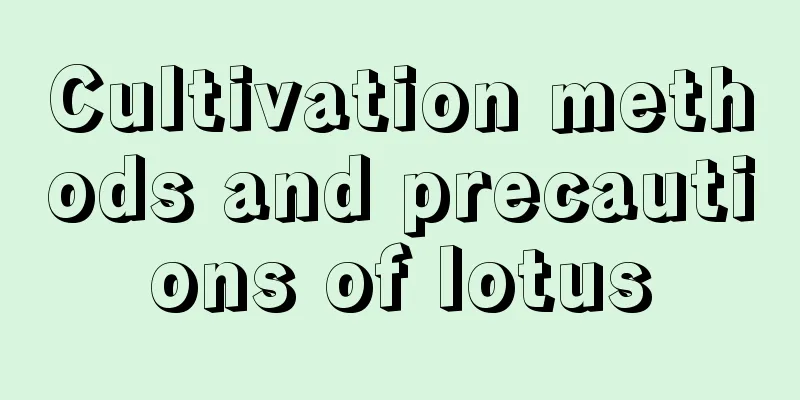Cultivation methods and precautions of lotus

1. Maintenance methods1. Temperature: The lotus likes warmth, and the temperature between 15 and 24 degrees is more suitable. In addition, it is relatively afraid of cold. It may get frostbite below five degrees, and water will freeze below zero degrees, so you need to be careful. Of course, the temperature cannot be too high, and more ventilation is needed. 2. Light: Lotus generally likes light, but it is afraid of too strong light. So, in the summer, try to place it out of direct sunlight. You can also provide some shade at noon in other seasons, because too strong light will make its leaves and flowers wilt. 3. Changing water: Generally speaking, the lotus is aquatic, so you have to pay attention to changing water. If it is a small or medium-sized plant, the water surface height can be controlled between twenty and sixty centimeters. The frequency of water changes is generally once every twenty days, but the intervals can be slightly shorter in summer. 4. Fertilization: When fertilizing the lotus, the main thing used is nutrient solution. You can add it after changing the water, but not too much. 2. Breeding techniques1. Reproduction: It can be propagated by sowing. Because the seeds of the lotus have no dormancy period, they can generally be sown in all seasons. It is more suitable to sow in an aquatic environment. The water can be mountain spring water, and the culture soil can be pond mud, etc. Generally speaking, if sowing is done in spring, it takes about fifty to sixty days from sowing to flowering, and if sowing is done in autumn, it takes sixty to eighty days. 2. Pruning: When pruning the lotus, repairing the root system is a very important part. Because it is usually grown in water, there are often some rotten roots that need to be cut off in time. In addition, yellow and dry leaves can also be cut off in time. 3. Problem diagnosis and treatment1. Disease: A common disease is "root rot". In addition to this disease, there are also "black spot disease" and others, which harm leaves and flowers and can be treated with chlorothalonil. 2. Pests: The main types are called "spodoptera litura", "aphids", etc. They have strong reproductive abilities and can be controlled by pesticide sprays. IV. Other issues1. Toxicity: It is completely non-toxic and has a certain purification effect. 2. Can it be kept at home: Yes. It has good ornamental value and can be grown in water at home. |
<<: Doesn't the fig tree bloom?
>>: Phoenix breeding methods and precautions
Recommend
What to do if the leaves of the fortune tree wilt
1. Reduce watering Reason: Do not water too much ...
How long is the growth cycle of dianthus?
Introduction to Dianthus Growth Dianthus likes to...
What are the legends and meanings of dragon bone flower?
1. Flower language and meaning 1. Mighty and domi...
What are the cultivation methods and precautions of boxwood?
Boxwood cultivation method Boxwood is a plant of ...
Why do orchid leaves dry up?
1. Humidity is too low 1. Reason: Orchids are sui...
Lipstick flower cultivation methods and precautions
Soil selection for lipstick flower Lipstick flowe...
How to deal with small flies on green radish, why are the leaves turning yellow
1. Treatment methods 1. Insecticide: After discov...
How to grow dried flowers
1. Keep dry Dried flowers have been dehydrated, s...
How to fertilize hosta, so that the flowers can be bigger!
The degree of fertilizer required This plant has ...
Where do chestnuts grow? Where do chestnuts grow?
Growth habits of chestnut Chestnuts are native to...
Things to note when repotting Liulidian
How often should the Liuli Palace be repotted? Be...
Can Christmas cactus be placed indoors?
1. Can it be placed indoors? Under normal circums...
How to propagate dragon fruit and what to pay attention to
Dragon fruit reproduction method The main ways of...
What to do if lily of the valley has root rot
1. Reasons 1. Too much water This is the main rea...
The Flower Language of Fuchsia
1. Flower Language The flower language of fuchsia...









